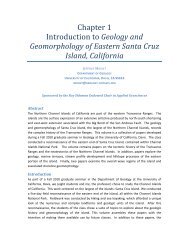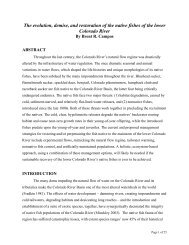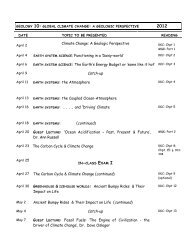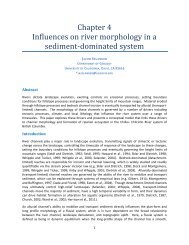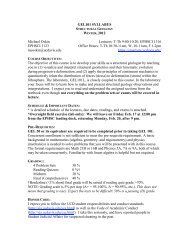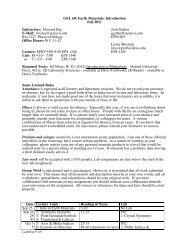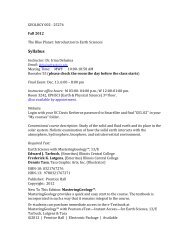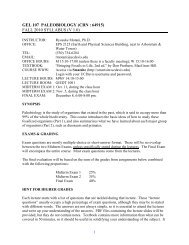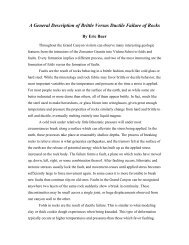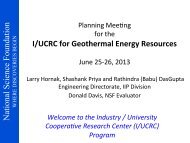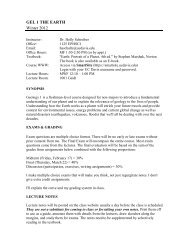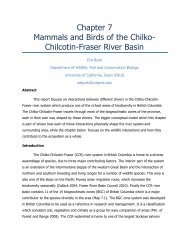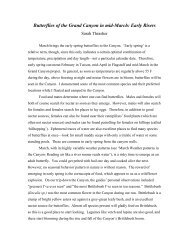Applying the Manning Equation to the Grande Ronde River
Applying the Manning Equation to the Grande Ronde River
Applying the Manning Equation to the Grande Ronde River
Create successful ePaper yourself
Turn your PDF publications into a flip-book with our unique Google optimized e-Paper software.
<strong>Applying</strong> <strong>the</strong> <strong>Manning</strong> <strong>Equation</strong> <strong>to</strong> <strong>the</strong> <strong>Grande</strong> <strong>Ronde</strong> <strong>River</strong><br />
by Ann Fissekis<br />
How fast is a river? A common question without a simple answer. Flow speed and rate<br />
vary depending on <strong>the</strong> characteristics of <strong>the</strong> channel that <strong>the</strong> fluid flows through. Specifically, <strong>the</strong><br />
channel’s slope, size and surface roughness affect a river’s flow. The relationship between flow<br />
and <strong>the</strong>se channel characteristics is represented in <strong>the</strong> <strong>Manning</strong> equation, which can be adjusted<br />
<strong>to</strong> determine both velocity and flowrate:<br />
V = (κ/n)*S (1/2) *R h<br />
(2/3)<br />
Q = (κ/n)*S (1/2) *R h (2/3) *A<br />
Where:<br />
V = velocity<br />
Q = flowrate<br />
κ = conversion fac<strong>to</strong>r = 1.00 (metric), 1.49 (British)<br />
n = channel roughness = 0.035 (value applies only <strong>to</strong> major rivers)<br />
S = channel slope = ~.004<br />
Rh = hydraulic radius = Area/Wetted Perimeter<br />
A = area<br />
Velocity measurements were taken with <strong>the</strong> <strong>Grande</strong> <strong>Ronde</strong> above La <strong>Grande</strong> (river mile<br />
172.8) and at <strong>the</strong> confluence with <strong>the</strong> Wallowa <strong>River</strong> (river mile 81.5). The results of both <strong>the</strong><br />
measured and calculated flowrate are shown in table 1:<br />
Measured Q (m 3 /s) Calculated Q (m 3 /s) Percent Difference<br />
Upper <strong>Grande</strong> <strong>Ronde</strong> 1.65 4.3 160 %<br />
<strong>Grande</strong> <strong>Ronde</strong> above<br />
Wallowa<br />
5.15 14.3 178 %<br />
The large percent difference can be largely attributed <strong>to</strong> <strong>the</strong> assumption that <strong>the</strong> measured<br />
cross-sections were uniformly shaped as a rectangle ra<strong>the</strong>r than as a parabola. The additional<br />
area of <strong>the</strong> rectangular cross-section would account for <strong>the</strong> additional flow that <strong>the</strong> <strong>Manning</strong><br />
equation predicts This would be a major source or error as those values are counted twice in <strong>the</strong><br />
calculation: first in <strong>the</strong> hydraulic radius and again in <strong>the</strong> area. Also, ano<strong>the</strong>r source of error is <strong>the</strong><br />
assumption that <strong>the</strong> slope of <strong>the</strong> <strong>Grande</strong> <strong>Ronde</strong> is uniform for <strong>the</strong> entire length of <strong>the</strong> river. While<br />
this assumption is less likely <strong>to</strong> have produced such a large error, it would still affect <strong>the</strong> final<br />
results.
Figure 1: Discharge measurement location along <strong>the</strong> <strong>Grande</strong> <strong>Ronde</strong> <strong>River</strong> immediately above <strong>the</strong> confluence with<br />
<strong>the</strong> Wallowa <strong>River</strong> (RM 81.5)<br />
Figure 2: Discharge measurement location along <strong>the</strong> Upper <strong>Grande</strong> <strong>Ronde</strong> <strong>River</strong> (RM 172.8)



